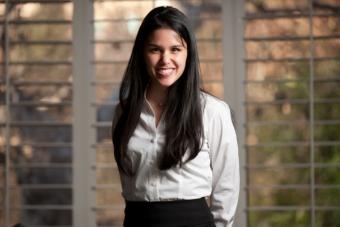Tenacity pays off for tissue engineer
 Public Impact Fellowship supports Seema Ehsan’s efforts to develop a better way of testing cancer drugs
Public Impact Fellowship supports Seema Ehsan’s efforts to develop a better way of testing cancer drugs
The cost of bringing a new drug to the marketplace, from discovery to clinical trials, ranges from $55 million to more than $1 billion. Seema Ehsan aspires to change that, particularly for cancer drugs. A chemical engineering doctoral candidate, she spends eight to 10 hours a day in the laboratory growing tumors.
“When I first learned about tissue engineering, I fell in love with it,” Ehsan says. “I think it’s amazing that we can re-create, regenerate or repair damaged tissue in the body using tools in the lab.”
Tissue engineering involves growing cells in three-dimensional structures. Typically, cells developed in a flat dish tend to behave as individual cells. But when cell cultures grow in a 3-D structure, they behave as they would in organ tissue. Engineers explore different methods of growing cells in scaffolds that dissolve once the cells reach a certain mass. The hope is that these cell cultures will mature into fully functional tissue and organs.
Ehsan wants to utilize her engineered tumors as a baseline platform to screen cancer drugs. “If we can mimic what’s happening in the body in the lab,” she says, “we can use our lab tumors to cost-effectively and efficiently test chemotherapies.”
Theoretically, her engineered tumors would more accurately predict human response than animal models, helping medical researchers do a better job of determining which drugs are ready for clinical trials. Over the last two years, she has conducted hundreds of tumor experiments with established cancer cell lines from the lung, breast and colon. It’s a gradual process. Lessons from each effort inform the next.
“Only in the past six months or so have things started to come together and get really exciting,” Ehsan says. Her next step is to learn how to isolate primary cell cultures directly from patient biopsies. Lab tumors grown from primary cancer cells would constitute an even more effective experimental model.
“This would enable our drug screening platform to significantly advance personalized cancer therapy,” Ehsan says. “There’s plenty of research showing that primary cell response to chemotherapies correlates much better with patient outcomes compared to established cell lines.”
She’ll spend the summer at a medical center in Japan collaborating with researchers who have developed a novel technique of in vitro manipulation and testing that complements her own work. She plans to begin using her platform with anticancer agents in the fall.
Her tenacity has earned Ehsan a UC Irvine 2012-13 Public Impact Fellowship. Instituted by Graduate Division Dean Frances Leslie, the $10,000 awards support UC Irvine graduate students whose work has the potential to benefit society.
“Seema is gifted at both experiment and theory. She seeks to understand tumor biology, which could lead to new discoveries affecting cancer therapy,” says her doctoral adviser, Dr. Steven George, professor of biomedical engineering and director of The Edwards Lifesciences Center for Advanced Cardiovascular Technology. “Seema’s work has a natural public impact.”
Ehsan, who grew up in Northern California, was gently nudged into the field of engineering by her father, a civil engineer with the California Department of Transportation. She earned a bachelor’s degree in chemical engineering at UC Berkeley and a master’s at UC Irvine and hopes to complete her Ph.D. next year.
With the Public Impact Fellowship, Ehsan is able to spend more concentrated time on her research. She says it also validates her efforts: “It’s nice to know that others believe in my work, but my primary motivation comes from knowing that if this research is successful, I’ll be contributing to science and helping people.”
